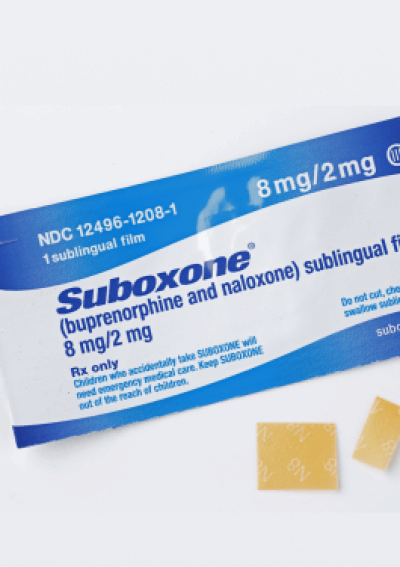Suboxone
Doctors prescribe Suboxone to treat opioid addiction, along with behavioral therapy and counseling. The drug combines buprenorphine, which acts partially like an opioid, with the opioid antagonist naloxone. This makes the brain believe it receives a full opioid without producing a euphoric high.

What Is Suboxone Used to Treat?
Suboxone is a prescription drug doctors use to treat opioid dependency in adults. Prescribing it along with appropriate behavioral therapy and counseling can help lower dependence on opiates. It reduces withdrawal symptoms while stopping opioid use, mimicking some of the drugs’ effects on the body.
Suboxone Sublingual Film is a prescription medicine used to treat opioid addiction in adults and is part of a complete treatment program that also includes counseling and behavioral therapy.
Doctors and addiction treatment centers may choose to use Suboxone to assist patients as they stop taking opioids. It contains buprenorphine, which is a Schedule III drug also used to treat pain.
How Does It Work?
Suboxone contains two drugs that work together to trick the patient’s brain into thinking it’s receiving an opioid without getting high. Buprenorphine is a synthetic partial opioid agonist. It acts similarly to a full opioid in the brain, activating some of the same receptors. However, it doesn’t produce the euphoric high associated with opioids.
Suboxone combines buprenorphine with naloxone, an opioid antagonist. Naloxone binds to opioid receptors in the brain to block other drugs from binding to them. This makes it an effective counter to buprenorphine and helps discourage inappropriate use. Naloxone is also used to treat acute overdoses of other opioid drugs, including heroin, morphine and oxycodone.
Both medications can work alone to treat chemical dependency. However, when combined, naloxone acts as a sort of safety guard against misuse. Improper use of naloxone, in combination with buprenorphine, can lead to withdrawal symptoms.
How to Take Suboxone
Patients take Suboxone as a sublingual film or tablet they place under the tongue. It’s important to take Suboxone doses at the correct time. If you miss a dose, take it as soon as you remember. However, if it’s almost time for your next dose, skip the missed one and resume your normal schedule.
Never take two doses of Suboxone at the same time. Contact your doctor if you’re unsure what to do.
| Suboxone film | Buprenorphine | Naloxone |
|---|---|---|
| 2 mg/0.5 mg | 2 mg | 0.5 mg |
| 4 mg/1 mg | 4 mg | 1 mg |
| 8 mg/2 mg | 6 mg | 2 mg |
| 12 mg/3 mg | 8 mg | 3 mg |
Patients must maintain consistent dosing to achieve the desired effect. If a patient has previously used buprenorphine, they only should begin Suboxone treatment with a film containing the same dose.
Taking too much Suboxone is potentially dangerous. Call Poison Control immediately if you take too much. Signs of an overdose include low blood pressure, pinpoint pupils, sedation and slow, shallow breathing. Taking alcohol, antidepressants, benzodiazepines, sedatives or tranquilizers at the same time as Suboxone can increase the risk of overdose.
What Are the Common Side Effects of Suboxone?
The most common side effects of taking Suboxone include headache, pain and difficulty sleeping. Many patients also report some digestive upset, including nausea and vomiting.
- Constipation
- Excessive sweating
- Headache
- Insomnia
- Nausea
- Pain
- Tongue pain
- Vomiting
These are not all of the possible side effects associated with taking Suboxone. If you experience side effects while taking Suboxone, contact your healthcare provider. Don’t stop taking your medication, as this could cause additional or worsening symptoms.
Are There Serious Suboxone Side Effects?
Some serious side effects of taking Suboxone include respiratory complications and allergic reactions. If left untreated, these could be fatal. Patients should immediately report any side effects to a healthcare provider.
- Agitation or hallucinations
- Blurry vision
- Bruising easily
- Confusion
- Difficulty breathing
- Jaundice
- Swelling of the face (throat, mouth or tongue)
- Trouble swallowing
Suboxone can depress respiratory function. Therefore, patients should report any difficulty breathing immediately. Additionally, allergic reactions, including facial or throat swelling, require immediate medical attention.
Warnings for Suboxone
Suboxone labeling includes multiple warnings about possible side effects and complications. For example, patients should not take buprenorphine with other drugs, such as alcohol, that can depress the central nervous system.
- Adrenal insufficiency: Opioid-induced adrenal insufficiency causes the body to produce inadequate amounts of certain hormones. It requires careful monitoring and treatment by a physician.
- Allergic reaction: Allergic reactions, including anaphylaxis, can result from taking Suboxone. Anyone with known hypersensitivity or allergy to buprenorphine or naloxone should not take it.
- Central nervous system depression: Like full opioids, buprenorphine when combined with depressant drugs can slow down brain activity, resulting in decreased breathing and heart rate as well as possible loss of consciousness. CNS depression can result in death if untreated.
- Dental injury: Numerous individuals reported dental injuries with Suboxone use. The most common issues include cavities and tooth decay resulting in extraction.
- Dependence: It’s possible to become dependent on Suboxone. Withdrawal symptoms are generally milder than with a full opioid.
- Head injury: Because buprenorphine can elevate cerebrospinal fluid pressure, it may not be an appropriate treatment option for individuals with head injuries.
- Hepatitis risk: There are multiple reports of hepatitis and related conditions associated with Suboxone use. Routine liver function tests can help detect any abnormalities.
- Impaired abilities: The medications in Suboxone can impair reasoning abilities and reaction times. Avoid driving or operating machinery until you know how you will react.
- Neonatal opioid withdrawal syndrome: It’s possible for babies born to mothers taking Suboxone to develop withdrawal symptoms. Careful monitoring and rapid treatment are necessary.
- Respiratory depression: Suboxone is directly linked to depressed respiration. This causes slow, shallow breathing.
Patients should always disclose any relevant information about drug sensitivities, injuries, medical conditions and other concerns to a healthcare provider before beginning Suboxone treatment. Failure to do so could result in serious complications and possibly death.
Possible Breathing Complications With Suboxone
Buprenorphine is directly linked to depressed respiratory function. It can lead to serious breathing complications, including hypoventilation. This can cause a lack of oxygen reaching the brain, which can result in death.
Potential breathing complications are the most serious adverse effects associated with Suboxone use. Proper and safe medication dosing can limit complications. Careful monitoring of patients to ensure medication adherence is crucial.
Who Shouldn’t Take Suboxone?
Contraindications for Suboxone include patients taking some prescriptions and those with respiratory complications. Anyone with a known allergy or hypersensitivity to Suboxone’s ingredients shouldn’t take the medication. Severe allergic reactions can include difficulty breathing, skin rashes or hives, and anaphylaxis.
Elderly patients should exercise caution when taking Suboxone. Studies on the drug haven’t included a substantial number of individuals over 65, so potential adverse effects for older people are largely unknown.
- Compromised respiratory function
- Hypersensitivity or allergy to buprenorphine or naloxone
- Taking benzodiazepines or other CNS depressants, antiretrovirals, serotonergic drugs or CYP3A4 inhibitors or inducers
Studies have generally shown Suboxone as safe for pregnant and breastfeeding individuals; however, it’s a good idea to discuss the risks of Suboxone with a healthcare provider before taking it. Medications can pass to and affect a developing fetus. Additionally, both buprenorphine and naloxone can pass through to breast milk at very low levels.
There is a risk of becoming dependent on Suboxone, and doctors must use their best judgment in deciding if its use is likely to be successful. Patients who abuse buprenorphine during treatment may need further intervention and structured treatment.
Suboxone Drug Maker Sued Over Tooth Decay Claims
In December 2023, the U.S. Judicial Panel on Multidistrict Litigation announced that it would consider merging 15 Suboxone lawsuits into a multidistrict litigation during its hearing on January 25, 2024.
Suboxone lawsuits claim that the drug’s manufacturer, Indivior, put profit ahead of patient safety in marketing the drug despite multiple reports of concerns. The FDA received hundreds of reports of tooth decay related to using Suboxone sublingual medications. Plaintiffs claim the film version of Suboxone caused enamel loss, which resulted in excess decay and tooth extractions.
The patients involved in the lawsuits had good dental health before taking Suboxone. Dental injuries claimed include excessive cavities, tooth decay, tooth loss and extractions. Patients also reported tongue injuries and gum disease after using Suboxone. Many reported needing dental work costing thousands of dollars.
FDA Warns About Suboxone Dental Injuries
The FDA released a warning in January 2022 about the risk of dental damage after using orally dissolving buprenorphine products. It cautions that the products may cause dental injuries including tooth decay, tooth loss and infections that are sometimes serious. However, the FDA also notes that medications containing buprenorphine, such as Suboxone, are an important tool in fighting opioid dependency.
The FDA recommends patients continue taking Suboxone as prescribed until they can discuss the potential risks and alternative options with a healthcare provider. Anyone experiencing a side effect from a medication can report it to the FDA MedWatch program.
What Can I Take Instead of Suboxone?
Individuals who choose to forgo treatment with Suboxone have several other options, such as taking buprenorphine or naloxone alone. Many medications have limited evidence supporting their use to treat opioid addiction. There is strong evidence to support the use of cognitive behavioral therapy, either alone or in conjunction with medication, to treat chemical dependency.
- Buprenorphine
- Cognitive behavioral therapy
- Naloxone
- Methadone
- Slow-release naltrexone
Anyone already taking Suboxone to treat opioid dependence should continue taking the medication until discussing an alternative plan with their healthcare provider. Stopping the medication suddenly can lead to withdrawal symptoms and other complications.
9 Cited Research Articles
Consumernotice.org adheres to the highest ethical standards for content production and references only credible sources of information, including government reports, interviews with experts, highly regarded nonprofit organizations, peer-reviewed journals, court records and academic organizations. You can learn more about our dedication to relevance, accuracy and transparency by reading our editorial policy.
- National Library of Medicine. (2023, May 15). Buprenorphine Sublingual and Buccal (opioid dependence). Retrieved from https://medlineplus.gov/druginfo/meds/a605002.html
- Kumar, R., Viswanath, O. & Saadabadi, A. (2023, April 29). Buprenorphine. Retrieved from https://www.ncbi.nlm.nih.gov/books/NBK459126/
- European Medicines Agency. (2023, January 17). Suboxone. Retrieved from https://www.ema.europa.eu/en/medicines/human/EPAR/suboxone
- Indivior. (2023). Highlights of Prescribing Information. Retrieved from https://www.indivior.com/admin/resources/dam/id/1073/Suboxone_PI.pdf
- Indivior. (2023). Medication Guide. Retrieved from https://www.indivior.com/admin/resources/dam/id/1071/Suboxone_MedGuide.pdf
- Indivior. (2023). Suboxone. Retrieved from https://www.suboxone.com/
- FDA. (2022, January 21). FDA warns about dental problems with buprenorphine medicines dissolved in the mouth to treat opioid use disorder and pain. Retrieved from https://www.fda.gov/drugs/drug-safety-and-availability/fda-warns-about-dental-problems-buprenorphine-medicines-dissolved-mouth-treat-opioid-use-disorder
- Carroll, K.M. & Onken, L.S. (2013, April 23). Behavioral Therapies for Drug Abuse. Retrieved from https://www.ncbi.nlm.nih.gov/pmc/articles/PMC3633201/
- DailyMed. (2010, July 27). LABEL: SUBOXONE- buprenorphine hydrochloride and naloxone hydrochloride tablet. Retrieved from https://dailymed.nlm.nih.gov/dailymed/lookup.cfm?setid=97677ce7-9562-43d0-8b99-8d1f37c1e3c6
Calling this number connects you with a Consumer Notice, LLC representative. We will direct you to one of our trusted legal partners for a free case review.
Consumer Notice, LLC's trusted legal partners support the organization's mission to keep people safe from dangerous drugs and medical devices. For more information, visit our partners page.
855-502-1471
